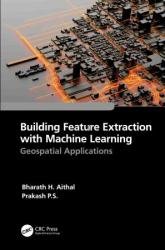 Название: Building Feature Extraction with Machine Learning: Geospatial Applications
Название: Building Feature Extraction with Machine Learning: Geospatial ApplicationsАвтор: Bharath H. Aithal, Prakash P.S.
Издательство: CRC Press
Год: 2023
Страниц: 145
Язык: английский
Формат: pdf (true)
Размер: 13.2 MB
Big geospatial datasets created by large infrastructure projects require massive computing resources to process. Feature extraction is a process used to reduce the initial set of raw data for manageable image processing, and Machine Learning (ML) is the science that supports it. This book focuses on feature extraction methods for optical geospatial data using ML. It is a practical guide for professionals and graduate students who are starting a career in information extraction. It explains spatial feature extraction in an easy-to-understand way and includes real case studies on how to collect height values for spatial features, how to develop 3D models in a map context, and others.
Geospatial technology is an emerging field of study that includes geographic information systems, remote sensing, and intelligent sensors. However, we can’t imagine any technology in the future without associating it with artificial intelligence and high-end computing. The domain has already witnessed significant automation penetration in satellite-based remote sensing, be it cloud detection or super-resolution methods. Prominent software tools, both open source and proprietary, extract features of interest using Machine Learning methods.
The United States Geological Survey (USGS) in collaboration with NASA has provided earth observation imagery data since 1972 to this day. These includes missions from Landsat 1 to Landsat 9, the recent Landsat 8 and Landsat 9 together, providing a full image of earth every eight days. The Landsat imagery datasets can be downloaded from Earth Explorer using a graphical user interface or landsatxplore Python package through a command-line interface or a Python API. A code snippet is provided here for downloading Landsat images using Python API, which can be used in Google Collaboratory.
Copernicus is the European Union’s earth observation programme, started its first satellite in 2014 and targeted to place about 20 satellites into orbit by 2030. The satellite constellation consists of the Sentinel family and other contributing missions. Atmosphere, Marine, Land, Climate change, Security and Emergency are six thematic areas to which Copernicus missions contribute. The datasets can be accessed through Copernicus Open Access Hub and also through Sentinel Python API.
The model’s output is the same size, shape, coordinate reference system, and datum as the input image, making subsequent analysis of the results easier. The models are created using the Anaconda open-source software in a Python environment. The results show that the model outputs are better than other contemporary standard architecture at extracting building features quickly. The visual analysis and the metrics of the confusion matrix strongly support this. This approach could aid in creating building footprint databases for a variety of applications.
Features:
• Provides the basics of feature extraction methods and applications along with the fundamentals of Machine Learning
• Discusses in detail the application of Machine Learning techniques in geospatial building feature extraction
• Explains the methods for estimating object height from optical satellite remote sensing images using Python
• Includes case studies that demonstrate the use of machine learning models for building footprint extraction and photogrammetric methods for height assessment
• Highlights the potential of Machine Learning and geospatial technology for future project developments
This book will be of interest to professionals, researchers, and graduate students in geoscience and earth observation, Machine Learning and Data Science, civil engineers, and urban planners.
Скачать Building Feature Extraction with Machine Learning: Geospatial Applications